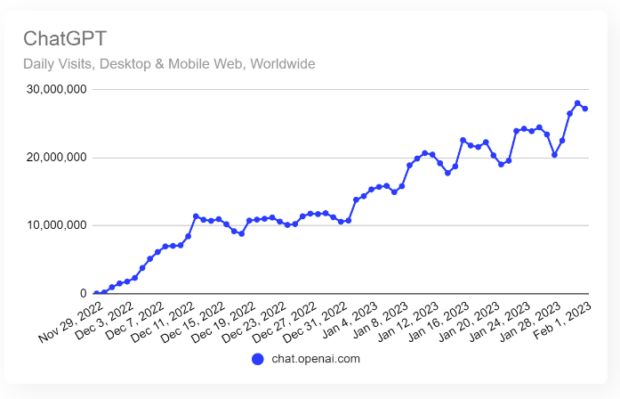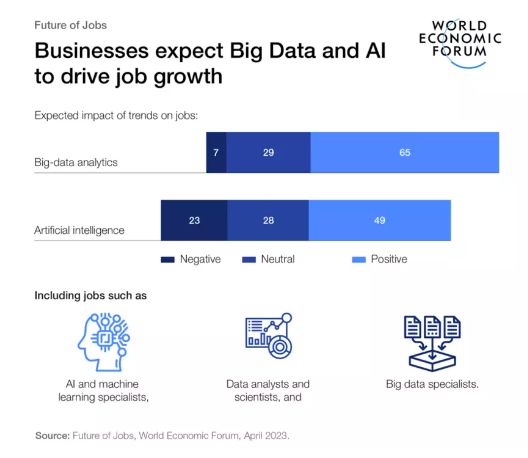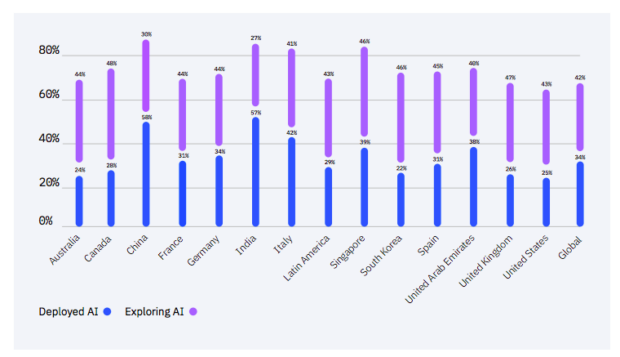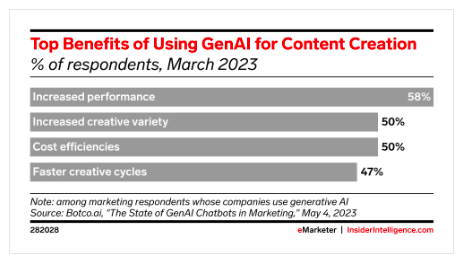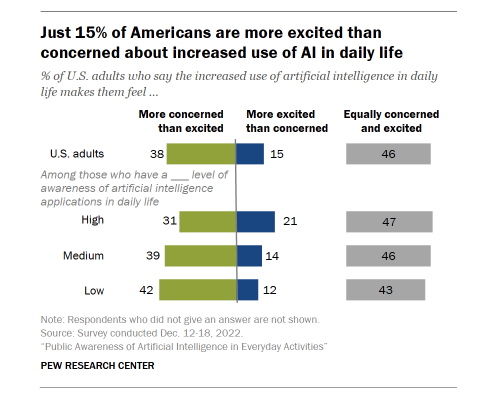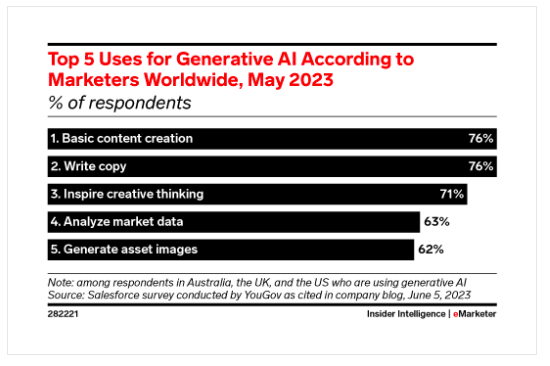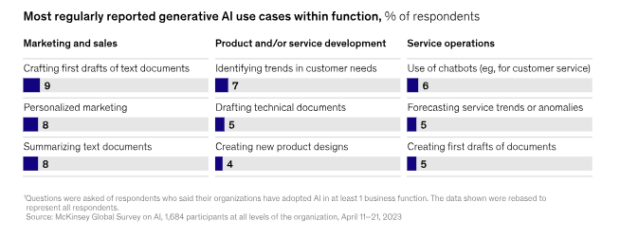Table of Contents
Artificial intelligence tools are a hot topic in marketing circles. Since ChatGPT burst onto the scene in late 2022, the adoption rates of AI have spiked. Research budgets have grown, and plans for how to use these new tools safely and effectively have been hatched.
In this post, we share 74 artificial intelligence stats that give a full picture of what both organizations and consumers think about AI. From top use cases to perceived value to emerging concerns, you’ll see what business leaders – and your potential customers – make of these new tools, so you can understand how best to implement them in your own workflow.
Bonus: Download this free cheat sheet with 250 professionally engineered ChatGPT prompts that will help you be more productive at work and in your daily life. We’ve included specific prompts for over 25 industries and professions!
74 artificial intelligence statistics for marketers
Artificial intelligence growth statistics
The pace at which businesses and individuals are adopting AI has not been seen with other emerging technologies. In fact, ChatGPT was the fastest growing app ever right out of the gate.
Source: Similarweb
- Chat GPT reached 100 million users faster than any other app. By February 2023, the chat.openai.com website saw an average of 25 million daily visitors. eMarketer predicts that more than 20% of all Americans will use ChatGPT at least once per month in 2024.
- GPT-3 was originally trained with 45 terabytes of data.
- The global AI market size is expected to be worth $407 billion by 2027. That’s a compound annual growth rate of 36.2% from 2022.
- 46% of U.S. adults think AI systems are being developed too fast. There’s a distinction along party lines here, with 41% Democrats saying AI is moving too fast compared to 52% of Republicans.
- More than 100 million people in the U.S. will use generative AI by 2024. By 2025, that number is expected to reach 116.9 million. eMarketer predicts that more than half of all Americans aged 12 to 44 will use generative AI by 2025.
- 96% of executives say generative AI is a hot topic of discussion with their boards.
- 45% of executives say the popularity of ChatGPT has led them to increase investment in AI.
- In May, the Biden Administration announced $140 million in funding to launch seven new National AI Research Institutes.
- That brings the total number of National AI Research Institutes in the United States to 25.
- 49% of employers expect AI to have a positive impact on job growth. By contrast, only 23% expect the impact of AI to be negative.
- However, only 38% of U.S. adults think AI will improve white collar job opportunities, while 42% think AI will reduce these opportunities. For blue collar jobs, 37% think AI will improve opportunities and 46% think they will get worse. Globally, 36% of workers expect AI to replace their current job.
- 66% of global adults say AI products and services will significantly change their lives in the next three to five years.
Source: World Economic Forum
Artificial intelligence usage statistics
So artificial intelligence use is growing fast. But what are people actually doing with these new tools? In this section, we’ll look at how business and consumers are using – and plan to use – AI technologies.
Source: IBM
- 34% of companies currently use AI, and an additional 42% are exploring AI.
- 28% of U.S. adults said their employer is using ChatGPT or similar chat-based tools. 19% said their employer is using AI image generators, 30% said their employer is using AI for data analysis, 21% said the employer is using AI tools for video generation, and 17% said their employer is using AI for HR and recruiting.
- 30% of IT professionals say their colleagues are using AI and automation tools to save time
- Larger companies are 100% more likely to use AI than smaller companies, but 41% of smaller companies are currently developing AI strategies.
- 35% of organizations are training and reskilling their teams to use new AI and automation tools
- 22% of respondents to a McKinsey survey say they regularly use generative AI in their work, while 79% said they had at least some exposure to generative AI.
- Americans are split on whether AI-generated written work can be as good as that created by a human. 44% said yes, while 40% said no. 36% said AI work can actually be better than content written by a person, but 47% disagreed.
- 48% of IT leaders told a Gartner Peer Community Survey said their organizations are using generative AI beyond ChatGPT, but only 12% are doing so extensively.
- 58% of U.S. adults are familiar with ChatGPT, but only 14% have tried it.
- 18% of U.S. adults aged 18 to 29 have used ChatGPT at work, compared to 8% of those aged 50-64.
- 27% of Americans say they interact with AI several times a day (or more).
- 21.4% of all Americans who use generative AI are aged 25 to 34. That makes them the biggest users of generative AI, followed by 35 to 44-year-olds (19.3) and 18 to 24-year-olds (14.0%).
- 49% of U.S. adults say they use AI to search for information, and 44% use AI to learn new things.
- 67% of adults say they have a good understanding of what AI is, but only 51% know which products and services use AI.

OwlyWriter AI instantly generates captions and content ideas for every social media network. It’s seriously easy.
Start free 30-day trialArtificial intelligence results statistics
What does all of this mean in terms of actual business results? Here, we’ll look at the current and expected benefits of artificial intelligence use in the workplace.
Source: eMarketer
- 58% of marketers whose companies use generative AI for content creation said increased performance is the top benefit.
- 54% of organizations are seeing cost savings and efficiencies from using AI in IT, business, or network processes.
- 52% are seeing improvements in IT or network performance.
- 48% are seeing a better customer experience.
- 67% of executives do not expect generative AI to significantly disrupt their industry.
- 69% of executives believe AI will lead to the emergence of new job roles.
- Executives expect customer engagement and satisfaction to improve by 9% within three years based on the use of generative AI.
- 68% of hiring professionals are hopeful or cautiously optimistic about the role of generative AI in recruiting.
Artificial intelligence trust statistics
Both brands and consumers have embraced artificial intelligence. But do we trust the tools, or are we simply putting up with them because they make our lives easier? The answer is a little bit of both. AI tools are trusted in some contexts, but not in others. Let’s see what the statistics about artificial intelligence trust reveal.
Source: Pew Research Center
- 38% of Americans are more concerned than excited about the increasing use of AI in daily life, while only 15% are more excited than concerned. 46% are equally excited and concerned.
- However, 74% of business executives believe the benefits of generative AI outweigh the potential risks.
- Only 23% of U.S. adults trust how generative AI is being used in social media, and 59% are worried about not understanding how AI algorithms work. 39% said they would trust influencers less if they increased their use of AI.
- Likewise, 37% of executives said the inability to explain results from generative AI algorithms is a challenge.
- 80% of U.S. adults are worried about AI being used to impersonate someone to access unauthorized information.
- 66% of U.S. adults are concerned about privacy issues involving the use of generative AI for social media.
- 27% of U.S. adults trust search results generated by AI, while 31% distrust those results.
- However, 75% of consumers trust content written by generative AI.
- 52% of adults say they trust companies that use AI as much as they trust other companies.
Source: Capgemini Research Institute
Artificial intelligence marketing statistics
What does all of this mean for your marketing strategy? The AI statistics show you’re probably talking about using artificial intelligence for marketing, even if you haven’t actually implemented these tools yet. Here’s how other brands are using AI for marketing, and what their executives view as the most important use cases.
Source: eMarketer
- Among marketers who are already using generative AI, 76% said they use it for basic content creation and to write copy.
- 62% of consumers are comfortable with generative AI in marketing and advertising, as long as it doesn’t affect the overall experience in a negative way.
- 64% of consumers are open to purchasing a new product recommended by generative AI.
- Likewise, 57% of U.S. adults are comfortable with AI targeting advertising to shoppers, and only 13% are “not at all comfortable” with this use of AI.
- 23% of marketing professionals in organizations use AI. Compare that to 54% of IT professionals.
- 26% of organizations are using AI for marketing and sales, while 22% are specifically using conversational AI or virtual assistants.
- 29% of companies are already using or considering using natural language processing (NLP) AI for marketing.
- 16% of organizations are using AI for sentiment analysis.
- 14% of organizations are using generative AI for marketing and sales.
- 53% of IT leaders who say their organizations use generative AI beyond ChatGPT use it for marketing and advertising.
- Gartner predicts 30% of outgoing marketing messages from large organizations will be generated by AI by 2025.
- 46% of organizations that already use AI said they use generative AI most for marketing and communications.
Artificial intelligence customer service statistics
For brands, customer service automation and support is an obvious implementation of AI tools. Chatbots are a well-known and accepted tool for customer service, especially on social media. AI makes those chatbots much more functional and personalized.
The stats show business are particularly keen on this use of generative AI. And consumers are overwhelmingly satisfied with the results.
Source: Capgemini Research Institute
- 35% of executives said virtual assistants for customer engagement are the top generative AI use case in sales and customer service.
- 38% of executives said customer experience and retention is the primary focus of their AI investments.
- 38% of companies are using or considering using NLP AI for customer care.
- 46% of IT leaders who said their organizations use generative AI beyond ChatGPT said they use it for customer service.
- 47% of organizations that already use AI said they use generative AI most for sales and customer service.
- 51% of those IT leaders say generative AI will have a substantial impact on improving customer experiences in the next year.
- 83% of business executives said that chatbots for automating customer service and improving knowledge management are the most relevant application of generative AI to their business.
- 67% of executives said that generative AI can improve customer service through automated and personalized support.
- 89% of consumers who regularly use generative AI chatbots are satisfied with their experience.
- However, people still want to be able to reach a human when they need to. 72% of U.S. adults are worried about being able to reach a human instead of interacting with AI. Only 5% are not at all worried about this.
- Access to a generative AI conversational assistant increases customer support agent productivity by an average of 14%.
- However, only 6% of organizations reported using generative AI for chatbots for customer service as of April 2023.
Source: McKinsey & Company
Artificial intelligence drives social media algorithms. Here’s what the AI stats tell us about social media.
- Facebook recommends about 15% of feed content from non-followed accounts based on artificial intelligence
- These AI recommendations have driven a 7% increase in overall time spent on the platform.
- Meta’s Llama 2 open source large language AI model was trained with 40% more data than Llama 1.
- Meta had 150,000 download requests for the model in the first week after Llama 2 was launched.
- In the two months after it launched, Snap’s My AI chatbot received 10 billion messages from 150 million users.
- Pinterest’s AI-powered “shop the look” product recommendations drove a 9% increase in conversions in their early tests.
- 50% of U.S. adults are interested in learning more about how generative AI is used in social media.
Save time managing your social media presence with Hootsuite. From a single dashboard, you can create content with an AI assistant, publish and schedule posts, find relevant conversions, engage the audience, measure results, and more. Try it free today.
Save time and grow faster with OwlyWriter AI, the tool that instantly generates social media captions and content ideas.
Free 30-Day Trial
